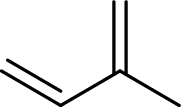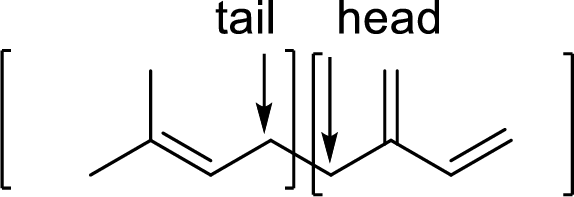
Chemistry In Context
9th Edition
ISBN: 9781259638145
Author: Fahlman, Bradley D., Purvis-roberts, Kathleen, Kirk, John S., Bentley, Anne K., Daubenmire, Patrick L., ELLIS, Jamie P., Mury, Michael T., American Chemical Society
Publisher: Mcgraw-hill Education,
expand_more
expand_more
format_list_bulleted
Concept explainers
Question
Chapter 9, Problem 12Q
Interpretation Introduction
Interpretation:
Whether the given two structures represent same arrangement and also the orientation of arrangement in each given structure have to be identified.
Concept Introduction:
Monomer: A molecule is considered as monomer when this molecule bonds with another identical molecule which results to form polymer.
Terpenes are made by joining five-carbon units, usually in a head to tail-fashion.
Isoprene unit:


Branched end of isoprene – Head
Unbranched end of isoprene - Tail
Expert Solution & Answer
Want to see the full answer?
Check out a sample textbook solution
Students have asked these similar questions
Sketch cis and trans structures for polychloroprene. Use two-dimensional Schematics.
نقطة واحدة
نقطة واحدة
نقطة واحدة
=
|||
१:०१
Most monomers are organic .12
materials, atoms are joined in
A. Hydrogen bonding.
B. Covalent bonding.
The development of modern .13
plastics started in 1920s using raw
material extracted from coal and
petroleum is products
A. Phenolic resin.
B. Polyethene.
C. PVC.
.Polymer structure are involve .14
A. One structure.
B. Three structure.
C. Two structure.
^
O
!
A sample of polyethene is found to have an approximate molar mass of 450 000 units.a. Calculate the approximate number of monomer units that are joined to make the molecules in this sample.b. What is the approximate chain length in terms of number of carbon atoms?
calculate
Chapter 9 Solutions
Chemistry In Context
Ch. 9.1 - Scientific Practices Tennis Anyone? Examine this...Ch. 9.3 - Prob. 9.2YTCh. 9.3 - Prob. 9.3YTCh. 9.4 - Prob. 9.4YTCh. 9.4 - Prob. 9.5YTCh. 9.4 - Prob. 9.6YTCh. 9.4 - Prob. 9.7YTCh. 9.4 - Prob. 9.8YTCh. 9.4 - Prob. 9.9YTCh. 9.5 - Prob. 9.10YT
Ch. 9.5 - Skill Building Benzene and Phenyl The difference...Ch. 9.5 - Prob. 9.13YTCh. 9.5 - Skill Building Polystyrene Possibilities Show the...Ch. 9.6 - Skill Building Esters and Polyesters You have seen...Ch. 9.6 - Prob. 9.16YTCh. 9.7 - Skill Building Kevlar Kevlar is a polyamide used...Ch. 9.8 - Prob. 9.20YTCh. 9.8 - Your Turn 9.22 Skill Building Burning a Plastic...Ch. 9.8 - Your Turn 9.23 Scientific Practices Landfill...Ch. 9.9 - Examine the values in Table 9.4 from the American...Ch. 9.9 - Prob. 9.25YTCh. 9.9 - Prob. 9.26YTCh. 9.9 - Prob. 9.28YTCh. 9.10 - Skill Building The Chemistry of PLA We dont show...Ch. 9.11 - Your Turn 9.31 Scientific Practices Glass or...Ch. 9.11 - Prob. 9.32YTCh. 9.11 - Skill Building Meet DEHP DEHP belongs to a common...Ch. 9 - Prob. 1QCh. 9 - Prob. 2QCh. 9 - Prob. 3QCh. 9 - Prob. 4QCh. 9 - Prob. 5QCh. 9 - Prob. 6QCh. 9 - Prob. 7QCh. 9 - Prob. 8QCh. 9 - Prob. 9QCh. 9 - Prob. 10QCh. 9 - Prob. 11QCh. 9 - Prob. 12QCh. 9 - Prob. 13QCh. 9 - Prob. 14QCh. 9 - Prob. 15QCh. 9 - Prob. 16QCh. 9 - Prob. 17QCh. 9 - Prob. 18QCh. 9 - Prob. 19QCh. 9 - Prob. 20QCh. 9 - Prob. 21QCh. 9 - Prob. 22QCh. 9 - Prob. 23QCh. 9 - Prob. 24QCh. 9 - Prob. 25QCh. 9 - Prob. 26QCh. 9 - Prob. 27QCh. 9 - Prob. 28QCh. 9 - Prob. 29QCh. 9 - Prob. 30QCh. 9 - Prob. 31QCh. 9 - Prob. 32QCh. 9 - Prob. 33QCh. 9 - Prob. 34QCh. 9 - Prob. 35QCh. 9 - Prob. 36QCh. 9 - Prob. 37QCh. 9 - Prob. 38QCh. 9 - Prob. 39QCh. 9 - Prob. 40QCh. 9 - Prob. 41QCh. 9 - Prob. 42QCh. 9 - Prob. 43QCh. 9 - Prob. 44QCh. 9 - Prob. 45QCh. 9 - Prob. 46QCh. 9 - Prob. 47QCh. 9 - Prob. 48QCh. 9 - Prob. 49QCh. 9 - Prob. 50QCh. 9 - Prob. 51QCh. 9 - Prob. 52QCh. 9 - Prob. 53QCh. 9 - Prob. 54QCh. 9 - Prob. 55QCh. 9 - Prob. 56QCh. 9 - Prob. 57QCh. 9 - Prob. 58QCh. 9 - Prob. 59Q
Knowledge Booster
Learn more about
Need a deep-dive on the concept behind this application? Look no further. Learn more about this topic, chemistry and related others by exploring similar questions and additional content below.Similar questions
- 1. Analyze the plastic Polyethylene terephthalate: a)What are the advantages (think properties) and disadvantages regarding your plastic? (Can it be recycled? Can it harm human health and/or environmental health.) b)What are the impacts of plastics (all plastics, not just the one you examined) with a sustainability plan: how can we reduce plastic pollution?arrow_forwardHigh-density polyethylene (HDPE) is opaque while low-density polyethylene (LDPE) is transparent. Briefly explain this phenomenon in terms of structure.arrow_forwardBased on the statement below, answer a-e. High density polyethylene (HDPE) fiber is used as liners for surgical gloves.Although the liner has a very high resistance to being cut, the polymerallows a surgeon to maintain a delicate sense of touch. The HDPE liner isusually rigid and not flexible. a. Suggest a reason why low density polyethylene, LDPE cannot be used. b. Give a molecular level reason why HDPE is successful in thisapplication. c. How does the molecular-level structure of HDPE and LDPE influence their physical properties? d. How do chemists control the production of LDPE and HDPE? e. Besides the extent of branching, what are other structural parameters that might lead to differences in physical properties of LDPE and HDPE?arrow_forward
- Directions: Answer the following completely. 1. Write the structure of the polymer, tetrafluoroethylene (up to 10 carbons in length). 2. Write the structure of polyvinylchloride (up to 10 carbons in length) 3. Write the structure of polystyrene (up to 10 carbons in length) 4. This is one of the coding symbols adopted by the plastics industry for packaging materials. What is the purpose of these coding symbols?arrow_forwardTwo biomolecules—starch and cellulose —illustrate how apparently minute differences in structure can result in vastly different properties ?arrow_forwardUse an example to show how branching and cross linking can affect the physical behavior of a polymer.arrow_forward
- A. Structural Isomerism of Alkanes, continued. Construct models for the five alkanes that have the molecular formula C6H₁4. All five of your models should have the same number of each type of atom, but they should have the atoms connected in a different order. Thus the molecules they represent are structural isomers of one another. Note the tetrahedral geometry of each carbon atom. Draw an extended and a condensed structure (NOT skeletal/line angle) of each structural isomer, then determine its IUPAC name. Recall that since the IUPAC name specifies the number of each type of atom and how they are connected, each structural isomer will have a different name. Each name should very specifically describe the structure. Isomer 3: Extended Structure Isomer 3: Condensed Structure IUPAC Name: IUPAC Name: Isomer 4: Extended Structure Isomer 4: Condensed Structurearrow_forward2. Heptane, hexane, and pentane are hydrocarbons. Rationalize the evaporation data of these substances based the type(s) of IMFs present in each and the relative strengths of these.arrow_forward2) Define the following terms in a few sentences, make drawings if necessary. Thermoplastics: Thermosets: Copolymer: Stereoisomerism: Spherulite:arrow_forward
- Bitumen (tar) is a mixture of various unsaturated (and also saturated) hydrocarbons of different chain lengths (it is used to make road pavement - asphalt). Based on your correlation, suggest a physical explanation of the fact that tar is black (i.e. absorbs light of all wavelengths).arrow_forwardPlease state the observation for Chemical properties of Hydrocarbons: Reaction with KMnO4: 1. Label three clean, dry test tubes with the name of the substance to be tested. 2. Place 4 drops of the sample to be tested in a test tube, carefully add 1 drop of 1% alkaline KMnO4. 3. Record your observations. 4. Disposal: All contents to be disposed into the waste container marked as organic waste. Wash the test tubes and clean them using brush, soap and water. Keep these inverted in the test tube rack. Data Table: Test tube Observations 1) Alkane 2) Alkene 3) Aromaticsarrow_forward. A compound has one cyclohexane ring and one cyclohexene ring connected to a 4 carbon chain. One of the rings has an OH substituent; one of the rings is a cyclohexanone and the four carbon chain contains a triple bond. The number of hydrogens in this molecule isarrow_forward
arrow_back_ios
SEE MORE QUESTIONS
arrow_forward_ios
Recommended textbooks for you
 Introductory Chemistry: A FoundationChemistryISBN:9781337399425Author:Steven S. Zumdahl, Donald J. DeCostePublisher:Cengage Learning
Introductory Chemistry: A FoundationChemistryISBN:9781337399425Author:Steven S. Zumdahl, Donald J. DeCostePublisher:Cengage Learning Chemistry for Engineering StudentsChemistryISBN:9781285199023Author:Lawrence S. Brown, Tom HolmePublisher:Cengage Learning
Chemistry for Engineering StudentsChemistryISBN:9781285199023Author:Lawrence S. Brown, Tom HolmePublisher:Cengage Learning
 Chemistry: The Molecular ScienceChemistryISBN:9781285199047Author:John W. Moore, Conrad L. StanitskiPublisher:Cengage Learning
Chemistry: The Molecular ScienceChemistryISBN:9781285199047Author:John W. Moore, Conrad L. StanitskiPublisher:Cengage Learning
 Organic ChemistryChemistryISBN:9781305580350Author:William H. Brown, Brent L. Iverson, Eric Anslyn, Christopher S. FootePublisher:Cengage Learning
Organic ChemistryChemistryISBN:9781305580350Author:William H. Brown, Brent L. Iverson, Eric Anslyn, Christopher S. FootePublisher:Cengage Learning

Introductory Chemistry: A Foundation
Chemistry
ISBN:9781337399425
Author:Steven S. Zumdahl, Donald J. DeCoste
Publisher:Cengage Learning

Chemistry for Engineering Students
Chemistry
ISBN:9781285199023
Author:Lawrence S. Brown, Tom Holme
Publisher:Cengage Learning


Chemistry: The Molecular Science
Chemistry
ISBN:9781285199047
Author:John W. Moore, Conrad L. Stanitski
Publisher:Cengage Learning


Organic Chemistry
Chemistry
ISBN:9781305580350
Author:William H. Brown, Brent L. Iverson, Eric Anslyn, Christopher S. Foote
Publisher:Cengage Learning
Chapter 4 Alkanes and Cycloalkanes Lesson 2; Author: Linda Hanson;https://www.youtube.com/watch?v=AL_CM_Btef4;License: Standard YouTube License, CC-BY
Chapter 4 Alkanes and Cycloalkanes Lesson 1; Author: Linda Hanson;https://www.youtube.com/watch?v=PPIa6EHJMJw;License: Standard Youtube License